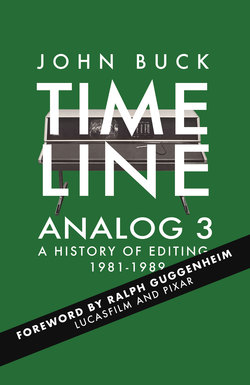Читать книгу Timeline Analog 3 - John Buck - Страница 17
На сайте Литреса книга снята с продажи.
ED-80
ОглавлениеAdrian Ettlinger worked away on yet another editing system. He called it the ED80 and like his previous systems it was controlled with a state of the art light pen. The user interface was modelled on an interactive medium as old as Hollywood itself.
The Script.
Displayed on a computer screen for the editor would be the production's final script and a text link to camera rushes on the database. Ettlinger completed the first round of coding for the working prototype and sought out opinion to guide him through the next phase.
Through a mutual friend he arranged for Bill Hogan, the proprietor of post-production facility Ruxton Ltd to fly to Alameda for a demonstration. Hogan had a long and distinguished career in many aspects of film and video and had just been named a co-winner of the Technical Achievement Academy Award for the engineering of the Universal City Studios 24fps color video system.
The system was used to cut the feature film Norman is that You? as Hogan recalls:
Obviously I had experienced quite a lot of different methods of electronic editing by this stage and nonlinear was ultimately just the progression of technology applied to a problem. I like technology and I may not be the best at picking all of the trends but I remember thinking that Adrian’s system was definitely a step forward from what we had and not just a ‘me-too’ copy of others.
The ability to try different edits from the same material and then decide which was better, to me was the fundamental difference with the ED-80. Ultimately you could be more creative and at the same time edit much faster.
The two men discussed the possibility of working together and marketing a completed ED-80, but it was obvious that there was a great deal of refining over many hours of coding to complete the system. Hogan knew the ideal candidate to assist Ettlinger in the process.
The young part-time Dubner Computer Systems engineer Andy Maltz was faced with a quandary. His parents had moved from New York to Los Angeles and Maltz knew that he would be spending some time on the West Coast. Then fate stepped in.
I got a call from Bill Hogan, who ran Ruxton Ltd, but I had no idea who he was in the industry. He told me he had been to the Dubner stand at NAB and had viewed the demonstration reel for the CBG-2. I would discover later that Bill had a real nose for new technology and had quickly decided he wanted to be the first on the West Coast to have a CBG-2, so he watched the entire demo reel that included the credits of the software engineers at the end of the reel.
He stored away the credit 'Growing States by Andy Maltz' and when he received my resume, he put two and two together. He said, "I see you're coming to California, I'm buying a CBG-2; why don't you come work at Ruxton through summer?"
Maltz moved to the West coast and into electronic editing.
